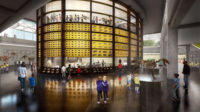For the second consecutive year, Los Angeles has reported the highest homeless population in the nation: 13,000 people, 95 percent of whom are living outdoors, according to the U.S. Department of Housing and Urban Development. While its root causes are diverse and complex— dwindling affordable housing, wealth stratification, lack of social services, and a warm climate among them— architecture students at the University of Southern California have designed an immediate solution: communities of modular, stackable, 92-square-foot “emergency stabilization” units that can be deployed in less than two weeks, just about anywhere.
Funded by Santa Monica design incubator the MADWORKSHOP Foundation, USC launched the Homeless Studio for 11 fourthyear students, instructed by faculty members R. Scott Mitchell and Sofia Borges, who is also the foundation’s acting director. The course, which included lectures from visiting homeless- rights activists and site visits to the Skid Row Housing Trust, culminated in a design competition for a temporary 30-unit residence for Hope of the Valley, a women’s shelter in Mission Hills, California.
“There’s no question that the best solution for homelessness is permanent housing,” says architect and MADWORKSHOP cofounder David C. Martin, but a temporary shelter for fewer than 30 people would not be beholden to the same code vetting as a permanent structure. “Those require a four- to five-year time frame, while right now there are people sleeping on the ground.”
The obvious shipping-container solution was out—Los Angeles does not recognize them as occupiable spaces without reengineering, and “living inside one would be pretty dismal,” says USC student Jeremy Carman, whose design team came up with the winning structure.
Together, the class built a prototype that features walls of aluminum-clad structural insulated panels (SIPs), framed by exposed steel beams. The structure’s ingenuity lies in the c-channel rails installed on the top and bottom of each; a small forklift or crane can slide one unit on top of another, while fasteners lock them in place. The bottom units, meanwhile, are slid and fastened onto seismic piers, which allow the units to be assembled on diverse terrain, whether that’s uneven land or the gravel of an empty lot. A convex back wall adds extra space for the length of a bed without crowding the limited floor space.
The versatility of these units greatly expands the possibilities of where they can be built, a typical obstacle when it comes to erecting shelters. “People will be very supportive of homeless housing, but not in their neighborhood,” says Mitchell.
The city government is paying attention. The Homeless Studio’s goal is to begin a pilot program in congressional districts that are actively looking for them, including L.A.’s Sylmar area. At $25,000 to construct each unit, the program is currently in fundraising stages. Promisingly, L.A. voters recently approved $1.2 billion in bonds to pay for the construction of 10,000 units of housing for homeless people, and the recent tragedy in the Oakland warehouse fire added new urgency for safe housing for displaced people. Neither client- nor sitespecific, the design opens itself to broader possibilities: interim worker housing, disaster shelters, recuperative care facilities.
“It’s L.A.-specific, but with broader applications,” says Borges. “The hardest thing was to get this through code, permitted, and passed in L.A., so if we do can do it here, we can do it anywhere.”




Post a comment to this article
Report Abusive Comment